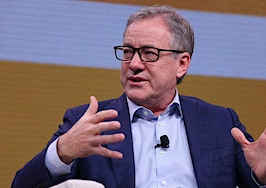At Inman Connect Las Vegas, July 30-Aug. 1, 2024, the noise and misinformation will be banished, all your big questions will be answered, and new business opportunities will be revealed. Join us.
When CoStar Group acquired Homes.com in 2021, it had spent years comfortably operating in the backfield while portal giants Zillow, Realtor.com and Redfin found themselves engaged in a long-simmering war for agent and consumer loyalty.
“We are very much focused on growth and growth for quality — we are not trying to have 100 million unique visitors,” former Homes.com President Dave Mele told Inman in 2015. “…For us, we don’t have to be the biggest; we take the Whole Foods or Trader Joe’s position of quality over quantity. We have a lot of respect for Zillow, but let’s just say we are different.”
TAKE THE INMAN INTEL INDEX SURVEY FOR JUNE
However, CoStar Group founder and CEO Andy Florance is never comfortable with less than first place.
The commercial magnate put the pedal to the metal with Homes.com, integrating Homesnap into Homes.com as Homes Pro, announcing an eye-popping $1 billion marketing budget, and employing a growth strategy that pushed Homes.com Network’s traffic to 156 million monthly unique visitors — well above the 100 million that, nine years ago, seemed impossible for the brand.
If that wasn’t enough to make the industry a believer in Florance’s “Your Listing, Your Lead” vision for Homes.com, CoStar Group’s $1.6 billion acquisition of Matterport and its digital twinning technology, which is expected to create a one-of-a-kind home search experience for listing agents and homebuyers, surely did.
“The acquisition may not immediately trigger the seismic industry reaction that occurred when chief rival Zillow bought ShowingTime,” Inman tech expert Craig Rowe said in May, “but when you think about what CoStar can do with Matterport, it just might.”

Andy Florance
With a stellar first and second quarter in the rearview, Homes.com won’t be taking a scenic ride through the latter half of the year.
“We’re basically doubling down,” Florance said. “We’ve seen great progress and we’ve seen great results from the marketing we’ve done to date, and we’re accelerating.”
“The results have been fantastic, so it shouldn’t surprise anybody that as we are on everyone’s computer screen, on everyone’s radio, on everyone’s TV, in their mobile device with the biggest marketing campaign ever getting more intense…” he added.
The next chapter of its $1 billion campaign will debut during the Paris Olympics, the NBA Finals, the U.S. Open, and the Stanley Cup and feature “a couple of new characters” alongside Jeff Goldblum, Dan Levy and Heidi Gardner.
Agents will see more advertising geared towards them, with the company seizing upcoming industry conferences as an opportunity to show the power of Homes.com for an industry inching closer to the implementation of several landmark multiple listing service (MLS) policy changes under the National Association of Realtors $418 million settlement.
“There are crazy rumors that went around that we were funding the plaintiff lawsuits, which was obviously obscene as they’re silly,” he said. “Because we’re doing something new and different in the United States; no one’s ever done what we’re doing before.”
“We market seller agency and buyer agency, but we market the home first, and then the agency capabilities of an agent, and that’s different,” he added. “[Those doubts] will go away because the results speak for themselves.”
Here’s what Florance had to say about the importance of portal traffic, the process of growing Homes.com’s membership, and the fallacy of “pure buyer’s agency” amid debates on how commission lawsuits will drive the next chapter of the portal wars.
This interview has been edited for length and clarity.
Inman: Let’s start with talking about the next chapter of Homes.com’s $1 billion advertising campaign. That $1 billion figure certainly drew some criticism from people who thought it was money ill-spent, but it seems that hasn’t been the case.
Florance: It’s been quite successful. We’ve been delivering about two billion impressions a month, but now we’re going to be a major presence in the [Paris] Olympics, the U.S. Open, the NBA Finals and the Stanley Cup. We’re also launching a new series of creative concepts using Heidi, Dan, and a couple of new characters that we’re not ready to disclose, but we’re really excited about it.
We’re focusing on sort of creating awareness in the residential world about what our site has to offer versus some other sites and focusing on the fact that on our site, you’re choosing the best agent. I think a lot of people don’t understand that when they hit the contact agent button on other sites, they’re basically being sold to an agent. I think that will probably be interesting as the world —as buyers and sellers — look more closely at the whole environment and how things work in the industry. We’re going to do that with humor and with good creative.
We’re now seeing that our clients’ properties, because of enhanced exposure of the actual property, they’re getting $11,000 more on average per sale and they’re selling in the first 10 days. We’re creating visibility around the value of marketing properties on the internet, which to date, no one’s really doing.
We’re now targeting increasing our backend goal to about 40 billion impressions against the market.
Forty billion. That’s another sort of mind-blowing number. What impact do those impressions actually make on Homes.com’s business, and how do they correlate with what’s happening with Homes.com’s traffic?
If you take our streaming broadcast major event sponsorship budget — the Superbowl, NBC, ABC, Netflix, Hulu, YouTube, all that stuff — we’re investing twice as much as all of the other competitors are investing combined. If you put in our digital marketing, we’re now running at about four times all of the other competitors combined.
We just finished our fourth month in a row of over 100 million unique visitors, and in fact, in the apples-to-apples comparison with the Homes.com Network, which is really the benefit members get exposure to, we’re at 156 million monthly.
We’re blowing away our goals for traffic. What we are as a company is a market aggregation function. We basically go out there and as efficiently as possible, acquire as many eyeballs — buyers and sellers — as [we] can pull together, and we’re concentrating that and then delivering that demand down to our customers.
If you just think about it logically, when you invest a billion dollars in marketing and the competitors don’t invest [as much] material money in marketing, you’re going to drive a lot of traffic, right? If you’re front and center of every newsfeed, every TV channel, etc. you get a lot of traffic.
So when you run 40 billion impressions in the back half of the year, we are going to deliver, for the year, about 2 billion visits to our customers’ property listings and their bios.
I went down the traffic rabbit hole for Inman in October, and I don’t want to get into the weeds too much today. But I do want to touch on portals’ focus on traffic. Some people feel it’s a little frivolous, especially compared to other metrics that could be discussed. Why does traffic really matter?
I was up in Chicago listening to a focus group. We do these focus groups anonymously around the country, and we talk to agents, and we talk to buyers and sellers. Agents are fascinated about how [Homes.com] is working; what’s going on. They’re just trying to sort it all out.
We’ve signed up over 8,000 agents for Homes.com membership, which far exceeds our expectations. There was a woman there, Laura, and I can send you a clip of it, she is winning listings using the product because she goes to homesellers and she has a really simple message: When you’re selling your home with me, your property’s going to be the top on a massively marketed internet platform with 156 million people [visiting] in a month, and your listing [is going to be] at the top of the results for Chicago or for your neighborhood.
And she actually [showed] her listing, [and she] had gotten a million views in the last 60 days.
So what she’s communicating to her homesellers is that she’s going to generate more interest for that home for sale, get more potential buyers and sell it at the best price. Our agent client can then pick up more business because she’s got a compelling story that differentiates her from everyone else.
The average Homes.com member account is getting 17 million impressions or views of their listings or their biography a year. Seventeen million.
So, touching on Homes.com membership. I listened to your Q1 earnings call and what stood out to me was the share of Homes.com members who had no listings. That raised some concerns for me; however, analysts I spoke to said it was a good sign that people with no listings still found value in the platform. Can you shine some more light on that? Is there a tipping point where that does become a problem?
I do a mechanical calculation that is useful for me. I know what it costs to acquire internet exposure better than anybody. Your typical click-through rate [per] impression is three percent, and the typical cost of a residential real estate term is somewhere around 15 cents for a click-through. So you can look at the value of the impressions you deliver to a client at exposure, and you can calculate if we’re delivering 19 million or 18 million impressions to a real estate agent; what would that cost them to acquire it on their own?
Give me a moment to calculate it. I’m giving you my full nerd.
Throw it my way. I’ll do my best to follow.
For a typical customer, we’re providing them with $82,000 of internet exposure for their brand during the course of the year. And they’re paying probably $6,000 for that. Then they’re also generating probably statistically or actuarially, they’re probably generating 30,000 to 40,000 in lead value, or if someone specifically calls up and says, “I wanna hire you.”
But the impression value is that you can buy your name at a bus stop and you can buy your name on the back of a softball or local softball jersey for a team, or you can be on the internet on a site that’s got a lot of people looking for homes. It’s all valid. So when I look at the value we provide to an agent who has listings, we’re providing them a 10-fold to 15-fold return on their investment, in my view.
If you have no listings whatsoever, we’re probably providing you with a three-fold return on your investment. But being honest, someone, and being, maybe, perhaps blunt, we don’t provide as much value to people who are not in real estate. We provide more value to people who are in real estate.
We don’t provide as much value to those people who aren’t really actively in the business or don’t have a track record in the business because we’re all about transparency. We’re a platform where people who have had successes in real estate can brag about what they’ve done. And while we do have thousands of people who have no listings using the platform, I think longer term, I think, we’re focusing our sales and marketing efforts on the folks who do have listings.
Players in the industry have spent a lot of time using a word that is not really real. People talk about buyer agents. I don’t think there’s buyer agency, but the fact is that if an agent has a year or more of experience, 97 percent of agents do both buyer agency and seller agency. So pure buyer agency is an extreme; it’s a unicorn.
And really, the people that do pure buyer agency are only the people who are dependent upon the lead diversion portals to generate buyer leads without a resume.
Hmm. I’ll have to chew on your last statement. I know we’re running out of time, so we’ll have to come back to that in a future conversation.
Staying on memberships — my colleagues had additional questions about the quality of Homes.com’s membership base. One colleague mentioned a time when you referenced ‘fake agents’ on the site, and another colleague has heard a few things on the grapevine about issues with membership cancellations. What insight can you provide about those two things?
Well, we don’t refer to fake agents on the website. But let’s be honest here. There is a lot of deception that occurs on these real estate portals that’s inappropriate. I’ve been to a dozen different cities. I’ve been in focus groups where we’ve interviewed hundreds and hundreds of home buyers and sellers, and they describe again and again and again that they feel deceived. They feel that they’ve been frankly lied to.
They see a home that’s for sale in an area they’re interested in, and they reach out to contact the agent. They click that button, ‘contact the agent,’ and they all believe that they’re contacting the agent on the property they’re looking at, right? And when the person on the other end of the phone answers them, they never say, ‘Hey, look, I had nothing to do with that property.’
There’s a deception thing happening there, and honestly, I think that lead diversion model that Realtor and Zillow use is gonna go away in the next three years. It’s not gonna work because the homeseller doesn’t like it.
The homeseller is putting their house on the market in order to sell it, right? They have a reasonable expectation that when they put their house on the market, that listing will be used to do the best job possible to sell the house. And if you’re honest about it, the answer is that’s not what’s happening right now. Their listing is being used to generate a buyer agency commission by deceiving someone that someone’s the aid contact point on the house.
If you take umbrage with the word fake … I’m not saying that any individual member of NAR is fake. I’m saying that the portal is being deceptive when they steal the leads from the homesellers and the listing agents, selling them off to a little pool of agents and then taking a huge cut.
Do I seem to have passion on that point?
Yes, you do. So, what do you have to say about the cancellation rate?
There was no expectation one way or another on the cancellation rate. We’re asking people to commit to a year, but we’re being extremely flexible. You sign up on your first day, you can cancel on your second day. So, the number one reason for cancellations right now is an inactive credit card, and a little bit of digging into that shows that about half of those people try to use a second credit card that doesn’t work.
So there’s probably more of a statement about the fact that the nature of 1.6 million real estate agents is that sometimes they have good cash flow, and sometimes they don’t have good cash flow.
The second thing is, you have people who expect it to work like other platforms. Our value proposition is not taking leads from a hundred agents and turning them over to you. We help you create more exposure for your listings and your agency.
We generate a lot of leads, but we generate leads for the house. We generate leads for seller agency and leads for buyer agency. So some people, probably most of the cancellations, happen in the first 30 days because they don’t get 10 buyer leads.
And that’s just a question of, that’s really not what we do. So we just let those people out, and we focus on the people for whom they want what we have to offer. We’re just being super flexible, and I think that’s a positive thing.













